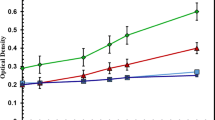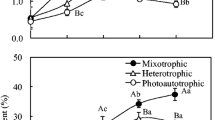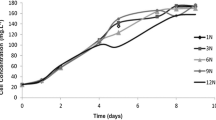Abstract
Heterotrophic cultivation of microalgae is vastly studied for the potential it offers as a scalable, space- and time-efficient way to produce biodiesel. From the perspective of economic feasibility, it is understood that renewable, waste-based sources of nutrients must be used to support the cultivation process. In this study, carrot pomace, a waste by-product of the juice industry, was utilized to fully replace synthetic growth medium in the heterotrophic cultivation of Auxenochlorella protothecoides. The carrot pomace underwent minimal pre-treatment to avoid incurring excessive costs. With carrot medium (CM) alone, 4.9 g/L total lipids (9.9 g lipid/kg wet carrot pomace), and with a 5 g/L addition of glucose to the CM, 5.9 g/L (11.8 g lipid/kg wet carrot pomace) could be produced, the latter of which was equivalent to the lipid output achieved with the optimized synthetic growth medium (control). The 5 g/L glucose addition improved the triacylglycerol (TAG) content of the lipids to 78.4%, which was equivalent to the control (76.4%). Growth medium prepared using carrot pomace alone as the sole source of carbon and nutrients was demonstrated to successfully support the growth and lipid production of A. protothecoides. The addition of 5 g/L glucose to the CM improved the lipid output by 19% and the TAG content by 18% and might be preferred for more efficient processing — at only a fraction of the cost of a completely synthetic growth medium, containing 30 g/L glucose in addition to other minerals and trace elements.





Similar content being viewed by others
References
Sajjadi B, Chen W-Y, Raman AAA, Ibrahim S (2018) Microalgae lipid and biomass for biofuel production: a comprehensive review on lipid enhancement strategies and their effects on fatty acid composition. Renew Sustain Energy Rev 97:200–232
Udaiyappan AFM, Hasan HA, Takriff MS, Abdullah SRS (2017) A review of the potentials, challenges and current status of microalgae biomass applications in industrial wastewater treatment. J Water Process Eng 20:8–21
Li G, Bai X, Li H et al (2019) Nutrients removal and biomass production from anaerobic digested effluent by microalgae: a review. Int J Agri Biol Eng 12:8–13
Lowrey J, Brooks MS, McGinn PJ (2015) Heterotrophic and mixotrophic cultivation of microalgae for biodiesel production in agricultural wastewaters and associated challenges—a critical review. J Appl Phycol 27:1485–1498
Perez-Garcia O, Bashan Y (2015) Microalgal heterotrophic and mixotrophic culturing for bio-refining: from metabolic routes to techno-economics. Algal biorefineries 61–131
Perez-Garcia O, Escalante FME, De-Bashan LE, Bashan Y (2011) Heterotrophic cultures of microalgae: metabolism and potential products. Water Res 45:11–36
Ende SSW, Noke A (2019) Heterotrophic microalgae production on food waste and by-products. J Appl Phycol 31:1565–1571. https://doi.org/10.1007/s10811-018-1697-6
Pereira I, Rangel A, Chagas B, et al (2021) Microalgae growth under mixotrophic condition using agro-industrial waste: a review. Biomass
da Silva TL, Moniz P, Silva C, Reis A (2021) The role of heterotrophic microalgae in waste conversion to biofuels and bioproducts. Processes 9:1090
Espinosa-Gonzalez I, Parashar A, Bressler DC (2014) Heterotrophic growth and lipid accumulation of Chlorella protothecoides in whey permeate, a dairy by-product stream, for biofuel production. Biores Technol 155:170–176. https://doi.org/10.1016/j.biortech.2013.12.028
Hui CJ, Liu L, Lim PE, Wei D (2019) Effects of sugarcane bagasse hydrolysate (SCBH) on cell growth and fatty acid accumulation of heterotrophic Chlorella protothecoides. Bioprocess Biosys Eng 42:1129–1142
Yan D, Lu Y, Chen Y-F, Wu Q (2011) Waste molasses alone displaces glucose-based medium for microalgal fermentation towards cost-saving biodiesel production. Bioresour Technol 102:6487–6493
Surbhi S, Verma RC, Deepak R et al (2018) A review: food, chemical composition and utilization of carrot (Daucus carota L.) pomace. Int J Chem Stud 6:2921–2926
Sharoba AM, Farrag MA, Abd El-Salam AM (2013) Utilization of some fruits and vegetables waste as a source of dietary fiber and its effect on the cake making and its quality attributes. J Agroaliment Process Technol 19:429–444
Anil P, Avanish K, Mishra AA (2016) Development and qualitative estimation of high fibre enriched bread fortified with carrot pomace. Food Sci Res J 7:51–56
Kausar H, Parveen S, Aziz MM, Saeed S (2018) Production of carrot pomace powder and its utilization in development of wheat flour cookies. J Agric Res 03681157:56
Sahni P, Shere DM (2018) Utilization of fruit and vegetable pomace as functional ingredient in bakery products: a review. Asian J Dairy Food Res 37:202–211
Bakshi MPS, Wadhwa M, Makkar HPS (2016) Waste to worth: vegetable wastes as animal feed. CAB Reviews: Perspectives in Agriculture, Veterinary Science, Nutrition and Natural Resources 11
Yeganehpour E, Taghizadeh A, Paya H, et al (2021) Utilization of fruit and vegetable wastes as an alternative renewable energy source in ruminants’ diet. Biomass Conversion and Biorefinery 1–9
Jafari F, Khodaiyan F, Kiani H, Hosseini SS (2017) Pectin from carrot pomace: optimization of extraction and physicochemical properties. Carbohydr Polym 157:1315–1322
Tiwari S, Upadhyay N, Singh AK et al (2019) Organic solvent-free extraction of carotenoids from carrot bio-waste and its physico-chemical properties. J Food Sci Technol 56:4678–4687
Umair M, Jabbar S, Nasiru MM et al (2021) Ultrasound-assisted extraction of carotenoids from carrot pomace and their optimization through response surface methodology. Molecules 26:6763
Yu C-Y, Jiang B-H, Duan K-J (2013) Production of bioethanol from carrot pomace using the thermotolerant yeast Kluyveromyces marxianus. Energies (Basel) 6:1794–1801
Demiray E, ErtuğrulKaratay S, Dönmez S, Dönmez G (2016) The usage of carrot pomace for bioethanol production. J Chil Chem Soc 61:2996–2998
Karatay SE, Demiray E, Dönmez G (2020) Usage potential of apple and carrot pomaces as raw materials for newly isolated yeast lipid-based biodiesel production. Biomass Conversion and Biorefinery 1–11
Tekin N, Ergörünlü B, Karatay SE, Dönmez G (2021) Enhanced lipid accumulation of Chlorella vulgaris with agricultural waste under optimized photoheterotrophic conditions. Biomass Conversion and Biorefinery 1–12
Andersen RA, Kawachi M (2005) Algal culturing techniques. Elsevier Academic Press
Xiong W, Li X, Xiang J, Wu Q (2008) High-density fermentation of microalga Chlorella protothecoides in bioreactor for microbio-diesel production. Appl Microbiol Biotechnol 78:29–36
Heredia-Arroyo T, Wei W, Hu B (2010) Oil accumulation via heterotrophic/mixotrophic Chlorella protothecoides. Appl Biochem Biotechnol 162:1978–1995
Mohan SV, Devi MP (2014) Salinity stress induced lipid synthesis to harness biodiesel during dual mode cultivation of mixotrophic microalgae. Bioresour Technol 165:288–294
Shen Y, Yuan W, Pei Z, Mao E (2010) Heterotrophic culture of Chlorella protothecoides in various nitrogen sources for lipid production. Appl Biochem Biotechnol 160:1674–1684
Bohutskyi P, Kula T, Kessler BA et al (2014) Mixed trophic state production process for microalgal biomass with high lipid content for generating biodiesel and biogas. Bioenergy Research 7:1174–1185. https://doi.org/10.1007/s12155-014-9453-5
Cao J, Yuan HL, Li BZ, Yang JS (2014) Significance evaluation of the effects of environmental factors on the lipid accumulation of Chlorella minutissima UTEX 2341 under low-nutrition heterotrophic condition. Biores Technol 152:177–184. https://doi.org/10.1016/j.biortech.2013.10.084
Patle S, Lal B (2007) Ethanol production from hydrolysed agricultural wastes using mixed culture of Zymomonas mobilis and Candida tropicalis. Biotechnol Lett 29:1839–1843
Miller GL (1959) Use of dinitrosalicylic acid reagent for determination of reducing sugar. Anal Chem 31:426–428
Federation WE, Association APH (2005) Standard methods for the examination of water and wastewater. American Public Health Association (APHA), Washington, DC, USA
Zhang X, Yan S, Tyagi RD et al (2014) Ultrasonication assisted lipid extraction from oleaginous microorganisms. Bioresour Technol 158:253–261
Garoma T, Janda D (2016) Investigation of the effects of microalgal cell concentration and electroporation, microwave and ultrasonication on lipid extraction efficiency. Renew Energy 86:117–123
Patel A, Arora N, Pruthi V, Pruthi PA (2019) A novel rapid ultrasonication-microwave treatment for total lipid extraction from wet oleaginous yeast biomass for sustainable biodiesel production. Ultrason Sonochem 51:504–516
Selstam E, Öquist G (1985) Effects of frost hardening on the composition of galactolipids and phospholipids occurring during isolation of chloroplast thylakoids from needles of scots pine. Plant Sci 42:41–48
Bligh EG, Dyer WJ (1959) A rapid method of total lipid extraction and purification. Can J Biochem Physiol 37:911–917
Liu J, Huang J, Jiang Y, Chen F (2012) Molasses-based growth and production of oil and astaxanthin by Chlorella zofingiensis. Bioresour Technol 107:393–398
Chiranjeevi P, Mohan SV (2016) Critical parametric influence on microalgae cultivation towards maximizing biomass growth with simultaneous lipid productivity. Renew Energy 98:64–71
Andeden EE, Ozturk S, Aslim B (2021) Effect of alkaline pH and nitrogen starvation on the triacylglycerol (TAG) content, growth, biochemical composition, and fatty acid profile of Auxenochlorella protothecoides KP7. J Appl Phycol 33:211–225. https://doi.org/10.1007/s10811-020
Mayo AW, Noike T (1994) Response of mixed cultures of Chlorella vulgaris and heterotrophic bacteria to variation of pH. Water Sci Technol 30:285
Zhou Y, He Y, Xiao X et al (2022) A novel and efficient strategy mediated with calcium carbonate-rich sources to remove ammonium sulfate from rare earth wastewater by heterotrophic Chlorella species. Bioresource Technology 343:125994
Wilson MR, Walker NA (1988) The transport and metabolism of urea in Chara australis: I. Passive diffusion, specific transport and metabolism of urea, thiourea and methylurea. J Exp Bot 39:739–751
Antia NJ, Berland BR, Bonin DJ, Maestrini SY (1977) Effects of urea concentration in supporting growth of certain marine microplanktonic algae. Phycologia 16:105–111
Bekheet IAT, Syrett PJ (1977) Urea-degrading enzymes in algae. Brit Phycol J 12:137–143
Mera R, Torres E, Abalde J (2016) Effects of sodium sulfate on the freshwater microalga Chlamydomonas moewusii: implications for the optimization of algal culture media. J Phycol 52:75–88
Zhang Z, Guo L, Liao Q et al (2021) Bacterial-algal coupling system for high strength mariculture wastewater treatment: effect of temperature on nutrient recovery and microalgae cultivation. Bioresource Technology 338:125574
Roleda MY, Slocombe SP, Leakey RJG et al (2013) Effects of temperature and nutrient regimes on biomass and lipid production by six oleaginous microalgae in batch culture employing a two-phase cultivation strategy. Bioresour Technol 129:439–449
Morales-Sánchez D, Tinoco-Valencia R, Caro-Bermúdez MA, Martinez A (2014) Culturing Neochloris oleoabundans microalga in a nitrogen-limited, heterotrophic fed-batch system to enhance lipid and carbohydrate accumulation. Algal Res 5:61–69
Chen CY, Lee MH, di Dong C et al (2020) Enhanced production of microalgal lipids using a heterotrophic marine microalga Thraustochytrium sp BM2. Biochemical Engineering Journal 154:107429
Gao B, Wang F, Huang L et al (2021) Biomass, lipid accumulation kinetics, and the transcriptome of heterotrophic oleaginous microalga Tetradesmus bernardii under different carbon and nitrogen sources. Biotechnol Biofuels 14:1–16
Ma F, Hanna MA (1999) Biodiesel production: a review. Bioresour Technol 70:1–15
Mu J, Li S, Chen D et al (2015) Enhanced biomass and oil production from sugarcane bagasse hydrolysate (SBH) by heterotrophic oleaginous microalga Chlorella protothecoides. Biores Technol 185:99–105
Karatay SE, Demiray E, Dönmez G (2019) Efficient approaches to convert Coniochaeta hoffmannii lipids into biodiesel by in-situ transesterification. Bioresour Technol 285:121321
Acknowledgements
Carrot pomace was kindly provided by GE-TA Tarım, Adana, Turkey.
Funding
The first author was financially supported by the 100/2000 PhD scholarship program of the Council of Higher Education (YÖK) of Turkey.
Author information
Authors and Affiliations
Corresponding author
Ethics declarations
Competing interests
The authors declare no competing interests.
Additional information
Publisher's note
Springer Nature remains neutral with regard to jurisdictional claims in published maps and institutional affiliations.
Rights and permissions
About this article
Cite this article
Çakır, Z.B., Yılmaz, H., Ertan, F. et al. Carrot pomace alone supports heterotrophic growth and lipid production of Auxenochlorella protothecoides. Biomass Conv. Bioref. 14, 7315–7327 (2024). https://doi.org/10.1007/s13399-022-02683-y
Received:
Revised:
Accepted:
Published:
Issue Date:
DOI: https://doi.org/10.1007/s13399-022-02683-y




